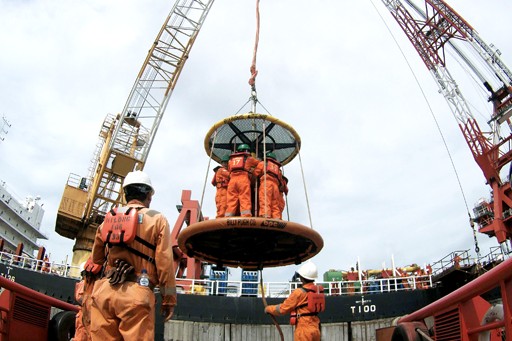Pertamina unit builds new oil rigs in East Java
Change Size
 Back to work: Pertamina Hulu Energi West Madura Offshore (PHE WMO) workers are moved in a personnel basket from a ship to the company’s oil rig off the coast of Madura Island in East Java. The company, a subsidiary of state-owned oil and gas giant Pertamina, is currently building two new oil rigs that will produce an additional 3,000 barrels of oil per day (bopd) on top of the current production output of 9,300 bopd. (JP/Wahyoe Boediwardhana)
Back to work: Pertamina Hulu Energi West Madura Offshore (PHE WMO) workers are moved in a personnel basket from a ship to the company’s oil rig off the coast of Madura Island in East Java. The company, a subsidiary of state-owned oil and gas giant Pertamina, is currently building two new oil rigs that will produce an additional 3,000 barrels of oil per day (bopd) on top of the current production output of 9,300 bopd. (JP/Wahyoe Boediwardhana)
O
il and gas firm Pertamina Hulu Energi West Madura Offshore (PHE WMO) has begun the construction of two oil rigs off the coast of Madura, East Java, in an attempt to increase national oil production.
PHE WMO is part of state-owned oil and gas giant Pertamina.
The two offshore rigs, PHE-12 and PHE-24, are expected to boost national oil production by 40 percent in 2019. At present, Pertamina only contributes 23 percent to the total national oil production, which amounts to 830,000 barrels of oil per day (bopd).
Pertamina president director Dwi Soetjipto said the construction of PHE-12 — which will produce oil — and PHE-24 — which will produce gas — would be a new standard for the firm to explore and exploit oil and gas.
The integrated oil and gas production facilities will be equipped with the Central Processing Platform 2 (CPP2), which is currently under construction in Cilegon, Banten, and will be shipped in mid-October.
The platform will then be installed offshore by the end of November.
Dwi said the new rigs were a milestone project as they extensively used local talent and locally made components.
“From the design to the construction, all will be done by local experts. The use of TKDN [local content] has reached 61.8 percent. This is proof that we are able to design and build our own [rigs],” he said off the coast of Madura recently.
The use of local components also helped to cut costs.
R. Gunung Sardjono Hadi, the president director of Pertamina Hulu Energi, which is the parent company of PHE WMO, said the integrated construction scheme would cost US$457 million.
The scheme has been approved by the Upstream Oil and Gas Regulatory Special Task Force (SKKMigas), according to its plan of development.
“There will be a cost reduction of 10 to 15 percent after price negotiations. This will result in lower costs as well,” he said, adding that Pertamina Hulu Energi had begun installing 19.5-kilometer-long subsea pipelines to distribute oil and gas from PHE-12 and PHE-24.
If the rigs are successfully constructed, Pertamina will see an additional supply of about 3,000 bopd and 15 million standard cubic feet per day (mmscfd) of natural gas. PHE WMO produces 9,300 bopd at present.
SKKMigas head Sunaryadi Amien said that if the construction went well, the two rigs would help exceed oil and gas production targets for 2017.
The country aims to produce 815,000 bpod and 1.15 million barrels of oil equivalent per day (boepd) of natural gas, which is in line with key performance indicators.
“This is evidence that Pertamina is able to build and design its own rig platform. This is in line with SKKMigas’ circular dated Aug. 12 on the obligation to use domestic shipyards,” Amien said.
Meanwhile, on Thursday, Pertamina received a cargo of liquefied petroleum gas (LPG) from Iran, marking the country’s first shipment as a new supplier of LPG to Indonesia.
Dwi welcomed the 44,000 metric tons of LPG — which was transported from Asaluyeh Port in Iran by the VLGC Pertamina Gas 2 vessel — at Kalbut Port in Situbondo, East Java.
He said the shipment from the National Iranian Oil Company (NIOC) would open up business development opportunities between Pertamina and the NIOC, in both the upstream and downstream sectors. (wnd)









